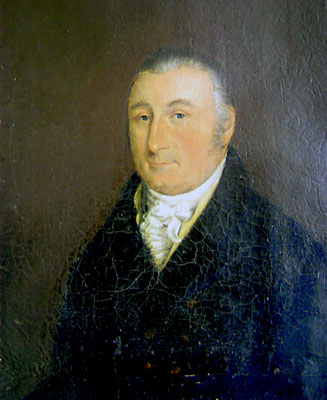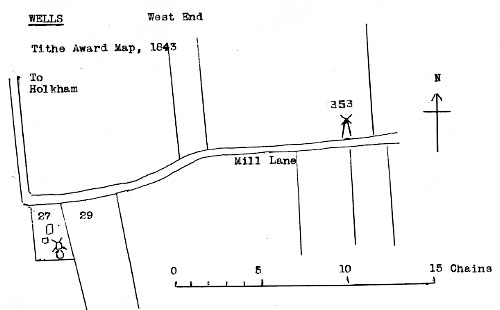
|
Wells
Mill Farm east postmill |
In 1797 there were two postmills standing side by side at Mill Farm, on the north side of Mill Lane - the east postmill and the west postmill, which was probably demolished in the early 1800s. |
To be Sold by Auction By Thomas Platten At the Fleece Inn, Wells, Norfolk On Saturday 13 February instant at 11 in the forenoon. All those Three Windmills, Horsemill and Stable (the horsemill capable of containing a large quantity of corn) situated at Wells aforesaid and now in the occupation of Mr. William Green, of which possession may be had immediately. Enquire of Mr. Robert Cole, Fakenham. Fakenham, Jan 30 1796. Norfolk Chronicle - 6th February 1796 |
 |
Peter 'The Miller' Hudson c.1815 |
John Hudson of Wells married Margerie Bloom at Holkham in 1662 and they had a son Peter Hudson of Wells who married Barbary Barns in 1709 and they had a son John Hudson of Wells (1713-1792) married Mary Hunnor (d. 1757), they had a daughter Ann (born 1747) who married Wells miller, Thomas Wilson - they had no children and a son Peter (The Miller) Hudson (1755 -1830) married Ann Cushion (d. 1778) in 1777 and then Mary Tinkler (1740 - 1819) (née Cordran) widow of William Tinkler and they had a son Peter Hudson jnr. (1780 - 1862) Peter and Mary owned extensive propery adjoining the old mill site. Mary's father in law Richard Tinkler (d.1764) owned an inn, outhouses, yards and orchards called Seven Sisters Yard, which by 1813 was known as the Three Tuns. The 1793 census shows Peter and Mary at The Three Tuns. Peter had a posting and provender business and he was known as 'Old Oats & Hay'. In 1780 their only son, Peter, (Warham) Hudson was born. Peter snr. and Mary probably worked in the family milling business on the north side of Mill Road moving to the site in 1815, leaving the Three Tuns to son Peter and his 8 children. In 1827, Peter Hudson jnr. took the tenancy of the 836 acre Church Farm in Warham, leaving his eldest son John in Wells to help his grandfather run the milling business. In Peter Hudson snr. died in 1830, leaving all his property to Peter Hudson jnr. with the exception of the milling business, which he left to his grandson, John Hudson. John Hudson (1805-1864) gave up milling c. 1838 and took over a farm at Wighton. The milling business was let to Daniel Brett. When John Hudson died in 1864, the mills were sold to clear his debts and this resulted in a family feud that was not settled until after World War II. William Husdson - March 2012 |
To be Sold by Private Contract |
Thomas Wilson made a will on 17th September, 1803. Peter Hudson, Innkeeper of Wells was named as executor. A Copyhold Messuage etc in Wells was to be left to his wife Ann. No mention was made of a windmill. The will was proved on 22nd May, 1807. |
To Millers |
 |
Tithe map 1843 - as redrawn by Harry Apling Mill farm towermill at Plot 353 West End postmill at Plot 27 |
Tithe Award 1845 |
||||
No. 353 |
Upper Mill Yard |
Arable |
0a. 0r. 23p. |
Part of £1. 17. 6 |
As both the postmill and the towermill were working on the site in 1843 was probable that West and Nichols were each operating one of the mills although they could have been in partnership. |
THE HURRICANE OF TUESDAY |
Local Bankrupts (From London Gazette) |
Bankruptcy Act, 1861 |
|
W. S. Higgins, Registrar |
| Norfolk News - 27th April 1863 |
To be Sold by Auction by Mr. Spicer at the Globe Inn, Wells, on Monday 11 July 1864 at 3 o'c |
Local Bankrupts (From London Gazette) |
Bankrupts (From London Gazette) |
To be Sold by Auction by Mr. R. Spicer |
THE BANKRUPTCY ACT 1861 |
James R. Brougham, Registrar. |
| Norfolk News - 30th March 1867 |
Daniel Brett was reported as being discharged of bankruptcy in 1863 and again in 1867, thus it would appear he became bankrupt twice in about 5 years while running the mill. |
White's 1836: Robert Brett, millwright, Mill lane |
Holkham Estate map 1714: Windmill |
If you have any memories, anecdotes or photos please let us know and we may be able to use them to update the site. By all means telephone 07836 675369 or
|
| Nat Grid Ref TF90954365 |
Copyright © Jonathan Neville 2012 |